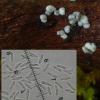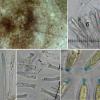
06-07-2014 21:26
Patrice TANCHAUDBonsoir,récolte réalisée en milieu humide, sur

08-05-2014 12:31
Hello,I found this frb on burnt grount. Size 0,4/0

05-07-2014 11:24
Bonjour à tous, Hi all, Quelqu'un a-t-il déjà

04-07-2014 16:03
Marja PennanenHi,these look like Godronia, but the microscophy i

20-06-2014 08:10
Bonjour trouvé en janvier a Mamoudzou Mayotte à
Mollisia discolor ?
Patrice TANCHAUD,
06-07-2014 21:26
récolte réalisée en milieu humide, sur brindille de bois de feuillu au sol. Spores d'une moyenne de 12,5 x 2,7 µm. Je verrais bien une ressemblance avec Mollisia discolor ...
Merci d'avance pour vos avis éventuels.
Patrice
Hans-Otto Baral,
06-07-2014 21:38

Re : Mollisia discolor ?
Not enough data. M. benesuada??



